January 2021 Science and Technology
Sakshi Education

- India to expand research, tourism in Arctic
India has unveiled a new draft ‘Arctic’ policy that, commits to expanding scientific research, “sustainable tourism” and mineral oil and gas exploration in the Arctic region.
The draft policy is open to public comments until 26 January 2021 and has been prepared after deliberations among several Ministries.
India expects the Goa-based National Centre for Polar and Ocean Research to lead scientific research and act as a nodal body to coordinate among various scientific bodies to promote domestic scientific research capacities by expanding “earth sciences, biological sciences, geosciences, climate change and space related programmes, dove-tailed with Arctic imperatives in Indian universities.”
Other objectives of the policy include “putting in place Arctic related programmes for mineral/oil and gas exploration in petroleum research institutes and encouraging tourism and hospitality sectors in building specialised capacities and awareness to engage with Arctic enterprises”.
India launched its first scientific expedition to the Arctic in 2007.
Arctic research will help India’s scientific community to study melting rates of the third pole — the Himalayan glaciers, which are endowed with the largest freshwater reserves in the world outside the geographic poles.
- India’s satellite spots rare hot ultraviolet-bright stars in the Milky Way galaxy
Rare hot Ultra Violet (UV)-bright stars have been spotted by astronomers with the help of India's first multi-wavelength space satellite AstroSat in the massive intriguing globular cluster in the Milky Way Galaxy called NGC 2808.
Scientists combined data of Ultraviolet Imaging Telescope (on board AstroSat) with observations made using other space missions like the Hubble Space Telescope and the Gaia telescope along with ground-based optical observations.
Hot UV-bright stars have been differentiated from the relatively cooler red giant and main-sequence stars.
One of the UV-bright stars was about 3000 times brighter than the Sun with a surface temperature of about 1,00,000 K.
Most of the stars were found to have evolved from a solar stage called the horizontal branch stars with hardly any outer envelope.
Thus, they were bound to skip the last major phase of life called the asymptotic giant phase (it is one of the last major phases in the life of stars) and directly become dead remnants or white dwarfs.
It helps in determining properties of these stars such as their surface temperatures, luminosities and radii.
- DRDO’s successful flight test of Smart Anti Airfield Weapon
DRDO successfully conducted captive and release trial of indigenously developed Smart Anti-Airfield Weapon (SAAW) from Hawk-I of Hindustan Aeronautics Limited (HAL) off the Odisha coast.
The smart weapon was successfully test fired from Indian Hawk-Mk132 of HAL.
This was the 9th successful mission of SAAW conducted by DRDO till now.
It was a text book launch, which met all mission objectives.
SAAW is indigenously designed and developed by DRDO’s Research Centre Imarat (RCI) Hyderabad.
This is 125 Kg class smart weapon, capable of engaging ground enemy airfield assets such as radars, bunkers, taxi tracks, and runways etc. up to a range of 100 kms.
The high precision guided bomb is light weight as compared to weapon system of the same class. The weapon was earlier successfully test fired from Jaguar aircraft.
- Tripartite agreement signed between MECL, RSMML and DMG for harnessing Potash in Rajasthan
Mineral Exploration Corporation Limited (MECL), Rajasthan State Mines & Minerals Limited (RSMML) and Department of Mines & Geology (DMG) has signed a tripartite agreement. The Rajasthan government is responsible for the feasibility study of Potash Solution Mining in Rajasthan.
Nagaur – Ganganagar Basin in the northwest of Rajasthan has a huge resource of 50,000 square kilometers of Potash and Halite.
Stratified Salt formations can be strategically used for underground oil storage, repositories for hydrogen, ammonia and helium gas, storage of compressed gas and nuclear waste.
Potash & Sodium Chloride from the Bedded Salt are widely used in Fertilizer Industry and Chemical Industry respectively.
Pave the way for the country's First Solution Mining Project, which will create jobs.
- CSIR-CMERI unveils ‘Aqua Rejuvenation Plant’ which facilitates an Organic Farming Model through treated Waste Water
CSIR-CMERI launched the “Aqua Rejuvenation Plant”, which promotes the development of Organic Farming Model through treated Waste Water.
CSIR-Central Mechanical Engineering Research Institute, Durgapur has launched the first Wastewater Treatment Technology Model, which can purify Irrigation/Farming Wastewater.
Aqua Rejuvenation Plant (ARP) is an Integrated Waste Water Rejuvenation Model with six-level purification characteristics, which can comprehensively treat wastewater according to various purification parameters.
Approximately 24,000 liters of water can be rejuvenated using ARP, which will be enough to meet nearly 4 acres of Agricultural Land (regardless of seasonal water demand).
The used filter media is specially developed for the treatment of Indian sewage water parameters and can be modified according to geographical changes.The filter media can also be obtained locally to ensure that there is no pressure in the supply chain for mass production of ARP.
Now, the treated water used for irrigation can even be used for drinking, and there is very little time for settling.
This system has a dual benefit, because when the treated water is used for irrigation purposes, the resulting filtered sludge can also be used as manure/fertilizer.
The biochar prepared from dry leaves falling in autumn season is also be used for soil mixing because it reduces the water required for irrigation, thereby saving valuable water.
- Government running rapid assessment system for feedback on COVID vaccination
The Government uses MEITY’s Rapid Assessment System (RAS) to process feedback on Covid vaccination.
“Rapid Assessment System (RAS)” is a platform developed by the National e-Governance Division, Ministry of Electronics & IT (MeitY) to obtain feedback from vaccinated people.
The plan aims to improve citizens’ vaccination experience while ensuring compliance with all norms during vaccination process in all vaccination centers.
This feedback system will help the Government make the vaccination process more citizen-friendly.
RAS was developed for online instant feedback (online or offline through the counter) of online e-services provided by the Indian Government and State Governments.
The main goal of RAS is to continuously evaluate the quality of e-services through feedback under each e-governance project, and to re-adjust the process to achieve the target benefits.
The RAS interface prompts citizens to provide feedback on service quality immediately after obtaining government electronic services.
The analysis function of RAS can help the integration department to improve the system and provide better services.
The registered mobile numbers and the names of those cell phones that have been vaccinated during the day are sent to the RAS system by the Co-WIN platform at midnight.
The RAS system prepares a unique URL for feedback and sends a personalized SMS to all beneficiaries on the day.
The questions asked will obtain information about the vaccination process, such as whether to maintain social distancing during the vaccination process, whether the staff inform patients about the vaccine and whether the vaccine is used correctly, whether adverse reactions are observed after immunization, etc.
- In the works, CSR-like policy for scientific community
The Ministry of Science and Technology has drafted a policy on the lines of the mandatory corporate social responsibility model for the country's scientific community, this was necessitated by scientists’ “isolation" from societal needs.
The “Scientific Social Responsibility” policy, under consultation for a year now, has been finalised and will soon be sent to the Union cabinet for approval.
As per the draft policy, every “knowledge worker” has to devote atleast 10 person-days each year to SSR activity, which can include giving lectures in schools and colleges, sharing infrastructure, conducting skill development workshops, and coming up with solutions to local environmental or health issues.
Beneficiaries can include students, school and college teachers, local bodies, communities, women’s groups, NGOs and MSMEs, among others.
While the knowledge worker would be given wide latitude in choosing the SSR activity, it should necessarily pertain to the transmission of scientific knowledge to society.
The policy envisages an SSR monitoring system in each institution to assess institutional projects and individual activity.
Institutes are also to publish their SSR activity as part of their annual reports. Individual SSR work is to be given due weightage in “performance evaluation of the knowledge worker, such as the performance-based assessment system the output of university and college teachers”.
- India successfully test-fires new-generation Akash missile
The Defense Research and Development Organization (DRDO) has successfully tested the surface-to-air Akash-NG (new generation) missile off the coast of Orissa.
The missile can intercept air threats. The missile was launched to enhance the defense system of the Indian Air Force (IAF).
Akash-NG is a medium-range mobile surface-to-air missile defense system.
It was developed by the Defense Research and Development Organization (DRDO).
The missile is jointly produced by Bharat Dynamics Co., Ltd. (BDL) and Balata Electronics Co. (BEL), which develops missile systems, Tata Power Strategic Engineering Department, and Larsen and Tuburo. The latter developed radars. Control center and launch system.
The missile has the ability to target aircraft at an altitude of 18,000 m at a distance of 50-60 km. Missiles can counteract air targets, such as fighter jets, cruise missiles and air-to-surface missiles.
The missile is fighting the Indian Army and the Indian Air Force. It uses an integrated ramjet propulsion system. The propulsion system provides continuous thrust for the missile after the initial rocket engine burns out until it is intercepted.
In December 2020, the Cabinet Security Committee chaired by Prime Minister Narendra Modi approved the export of the Akash missile defense system. After that, countries including the Philippines, Malaysia, Thailand, Belarus, the United Arab Emirates, and Vietnam showed interest in the Akash missile system.
The Akash battery includes a single Rajendra 3D passive electronically scanned array radar or Simple the Rajendra radar, and four launchers, each with three missiles. Each shell can track up to 64 targets and attack up to 12 targets. It consists of a 60 Kg highly explosive pre-fragmented warhead. The missile can protect the moving vehicle. It provides 2,000km² of air defense missile coverage.
- Andaman and Nicobar Islands flags off electric buses to curb pollution
The Lieutenant Governor of Andaman and Nicobar Islands, flagged-off fleet of electric buses.
The introduction of electric buses will help reduce tailpipe emissions and provide comfortable public transport.
NTPC VidyutVyapar Nigam Limited (NVVN Limited), a 100% subsidiary of NTPC Limited, a PSU under the Ministry of Power, is implementing a project of 40 electric buses.
In addition to the above projects, NVVN has become a bid-winning company, providing turnkey solutions for 90 electric buses in Bangalore under the Smart City project.
These buses will provide the last mile connection to the NAMMA Metro network.
NVVN is developing and providing complete zero-emission mobility solutions for various vehicle segments.
- UK establishes New Variant Assessment Platform to track Covid-19 mutation across world
The UK has launched a new global platform to track new COVID-19 variants. The platform will provide world-leading genomics expertise from the country to identify new variants of the virus.
The platform is part of the rotating presidency of the British Group of Seven. In this regard, the UK has also proposed a vision for a stronger, more collaborative and effective global health system to combat the COVID-19 pandemic and ensure that the international community is better prepared for future threats.
The platform will help to better understand the virus. It will also help to understand how it spreads. The platform is led by Public Health England (PHE), which also collaborates with NHS Test & Trace, academic partners, and the SARS-CoV-2 Global Laboratory Working Group of the World Health Organization (WHO).
It will also be led by the National Institute of Health Protection (NIHP) and will have PHE laboratories and personnel involved.
The concerned variant 202012/01 is a new variant of the corona virus (SARS-CoV-2). The new variant is also called lineage B.1.1.7, 20I / 501Y.V1, and because the virus appeared in the UK, it is usually called the British coronavirus variant. The transmission rate of the new variant is 36%-75% higher than that of wild-type SARS-CoV-2. The virus was first detected in November 2020 in samples collected in September 2020. The virus began to spread rapidly in mid-December.
SARS-CoV-2 is the abbreviation of "Severe Acute Respiratory Syndrome Coronavirus 2". The virus causes the 2019 Coronavirus Disease (COVID-19).
Coronavirus disease 2019 is an infectious disease caused by SARS-CoV-2. The first case of the disease was discovered in Wuhan, China in December 2019. The disease spread worldwide, and the world is still recovering from then on. The symptoms of COVID-19 are variable, starting from 1 to 14 days after exposure to the virus.
- DRDO develops India’s first indigenous 9mm Machine Pistol
 India’s first 9mm machine gun was jointly developed indigenously by the Infantry School and the Arms Research and Development Agency (ARDE) of DRDO Pune.
India’s first 9mm machine gun was jointly developed indigenously by the Infantry School and the Arms Research and Development Agency (ARDE) of DRDO Pune.
Machine guns are mainly self-loading pistols, which can be fully automatic or can fire bullets. The pistol was named "Asmi", which means "proud", "self-respect" and "hard work". The machine gun fired 9mm ammunition in use.
Its total unladen weight is less than 2 Kg, equipped with an 8-inch barrel and 33 rounds of large-capacity magazine.
Its upper receiver is made of aircraft-grade aluminum, and its lower receiver is made of Carbon Fibre.
The 3D printing process has been used in the design and prototyping of various parts, including trigger assemblies made of metal 3D printing.
This weapon has great potential in the armed forces and can be used as a personal weapon for heavy weapons detachments, commanders, tanks, aircraft crews, counter-insurgency and counter-terrorism operations.
The production cost of the machine gun may be lower than Rs. Each has 50,000 and has export potential.
- New monsoon forecast models on the anvil
The India Meteorological Department (IMD) may introduce new monsoon models this year to better forecast changes in rainfall.
Three different models that could be tested this year. Two of them were dynamical models and one a statistical model.
The monsoon that concluded in 2020 was unique, in that with monsoon 2019, it was only the third time in a century that India saw back-to-back years of above normal rainfall.
In both years — and monsoon 2019 was a 25-year high — the IMD failed to forecast the magnitude of the excess and only indicated that the monsoon would be “above normal”.
In the former, the climate on any particular day is simulated on supercomputers and meteorologists observe the changing daily output.
The other is the traditional statistical model that equates relationships of physical parameters, such as for instance sea surface temperatures, snowfall, the temperature of landmass etc, with the actual observed rainfall in the past.
The three models under consideration are: 12 global circulation models (dynamical) whose outputs would be combined into a single one; a model that gauges rainfall based on the sea surface temperature in the tropics and the statistical model based on climate variables observed during the pre-monsoon.
All of them are ‘ensembles’ meaning smaller models are combined to arrive at an average value.
- NASA shares pic of huge cluster of galaxies called Abell 370
NASA shared photos of the huge galaxy cluster named Abell 370. It is a cluster of galaxies four billion light-years away from the earth. The galaxy cluster is located in a constellation called Cetus.
The core of Abell 370 is composed of hundreds of galaxies. The galaxy was catalogued by George Abell, hence the name.
Abell 370 has several beams of light. These arcs are phantoms created by gravitational lensing on dark and huge objects between the observer and the distant galaxy.
The Abell 370 galaxy cluster was first discovered in 2002 using the lensing effect.
When the light from a galaxy (located at a great distance) passes through a large number of objects, the gravitational force from these objects can bend or twist them. This is called a gravitational lens.
Cetus is a sea monster in Greek mythology. The constellation Cetus is located in the sky area, and other constellations such as Pisces, Aquarius and Eridanus are also located in this area.
There are fourteen stars in the constellation of Cetus. Mira is the first star discovered in the constellation Cetus. The constellation Tau Ceti is the closest star to the sun.
Abell 370 Galaxy is also nicknamed The Dragon by NASA scientists. This is mainly because, in 2009, a study of Abell 370 revealed a group of galaxies in the background of star clusters. The group is regarded as a twisted dragon by the swarm. The head of the dragon is made of a spiral galaxy. These galaxies are 5 billion light-years away from each other.
Spiral galaxies are a type of Milky Way galaxy, consisting of a central concentration of stars called bulges and a flat rotating disk containing gas, stars, and dust. The Pinwheel Galaxy is a spiral galaxy.
- NIXI offers free Domain in local Indian languages
 The National Internet Exchange of India, NIXI, will offer a free Internationalized Domain Name, IDN, in any of the preferred 22 official Indian language along with every IN domain booked by the registrant.
The National Internet Exchange of India, NIXI, will offer a free Internationalized Domain Name, IDN, in any of the preferred 22 official Indian language along with every IN domain booked by the registrant.
Applicant will also get a free email in local language. This offer is valid for new .in users who register up to 31st of January. This offer is also extended to those existing in users who renew their domain in the month of January 2021.
NIXI is a not for profit organization.
It is working since 2003 for spreading the internet technology to the citizens of India through the activities like Internet Exchanges through which the internet data is exchanged amongst ISPs and between ISPs and CDNs, managing and operating Internet protocol IPv4 or IPv6 etc.
This offer has been created to stimulate the adoption of IDN domain name and proliferation of local language content.
- Arunachal puts India on vanadium map
Geological Survey of India (GSI) has carried out exploration in palaeo-proterozoic carbonaceous phyllite rocks in the Depo and Tamang areas of Papum Pare district in Arunachal Pradesh and placed this eastern Himalayan State on the vanadium map of the country. Now, this state likely to become India’s prime producer of vanadium.
It is recovered as a by-product from the slag collected from the processing of vanadiferous magnetite ores (iron ore).
This was the first report of a primary deposit of vanadium in India, with an average grade of 0.76% V2O5 [vanadium pentoxide].
India is a significant consumer of vanadium but is not a primary producer of the strategic metal.
India consumed 4% of about 84,000 tonnes of vanadium produced across the globe in 2017.
The largest deposits of vanadium of the world are in China, followed by Russia and South Africa.
China, which produces 57% of the world’s vanadium, consumed 44% of the metal in 2017.
Vanadium is a chemical element with the symbol V and atomic number 23. It is a hard, silvery-grey, malleable transition metal.
The elemental metal is rarely found in nature. It is recovered as a by-product from the slag collected from the processing of vanadiferous magnetite ores (iron ore).
Vanadium is a high-value metal used in strengthening steel and titanium.
- Make-in-India mega deal: 83 Tejas fighters cleared for Air Force
The Cabinet Committee on Security (CCS) cleared a deal worth nearly Rs 48,000 crore for the acquisition of 83 Tejas Light Combat Aircraft for the Indian Air Force
Designed by the Aeronautical Development Agency under the Department of Defence Research and Development
Manufactured by state-owned Hindustan Aeronautics Limited (HAL)
It will be an improvement over the Mk-1 version.
The indigenous content of the aircraft is 50 per cent and will be enhanced to 60 per cent.
It “will be a game changer for self-reliance in the Indian defence manufacturing”.
It is the largest indigenous defence procurement as part of measures to strengthen the armed forces amid a standoff with China on the Line of Actual Control and tensions with Pakistan over its terror infrastructure.
LCA-Tejas is going to be the backbone of the IAF fighter fleet in years to come and it “incorporates a large number of new technologies, many of which were never attempted in India.
LCA-Tejasprogramme would act as a catalyst for transforming the Indian aerospace manufacturing ecosystem into a vibrant Atmanirbhar-self-sustaining ecosystem.
- Ultra-high mobility electron gas can increase information transfer speed &data storage density in quantum devices
Scientists at Institute of Nano Science and Technology (INST), Mohali, Punjab have produced an ultra-high mobility Two dimensional (2D)-electron gas (2DEG).
Two Dimensional Electron Gas (2DEG) is an electron gas that is free to move in two dimensions, but tightly confined in the third. This tight confinement leads to quantized energy levels for motion in the third direction. Thus the electrons appear to be a 2D sheet embedded in a 3D world.
One of the most important recent developments in semiconductors, has been the achievement of structures in which the electronic behavior is essentially two-dimensional (2D).
Most 2DEGs are found in transistor-like structures made from semiconductors.
2DEG is a valuable system for exploring the physics of superconductivity magnetism and their coexistence.
Superconductivity is a phenomenon whereby a charge moves through a material without resistance. In theory this allows electrical energy to be transferred between two points with perfect efficiency, losing nothing to heat.
The need for attaining new functionalities in modern electronic devices has led to the manipulation of property of an electron called spin degree of freedom along with its charge. This has given rise to an altogether new field of spin-electronics or ‘spintronics’.
The manipulation of electron spin offers new dimensions for basic and applied research, and the potential for new capabilities for electronics technology. This motivates studies of spin polarized electrons in a high mobility two dimensional electron gas (2DEG).
- More effective ‘nanobodies’ to fight novel coronavirus
An international research team led by the University of Bonn (Germany) has identified and further developed novel antibody fragments (nanobodies) against SARS-CoV-2, the virus that causes Covid-19.
Nanobodies Against SARS-CoV-2 produced along with Antibodies: On injection of surface protein of the coronavirus into an alpaca and a llama, their immune system not only produced antibodies directed against the virus but also a simpler antibody variant that can serve as the basis of nanobodies.
They had also combined the nanobodies into potentially particularly effective molecules, which attack different parts of the virus simultaneously. This new approach could prevent the pathogen from evading the effect of antibodies through mutations.
Nanobodies appear to trigger a structural change before the virus encounters its target cell - an unexpected and novel mode of action. The change is likely to be irreversible; the virus is therefore no longer able to bind to host cells and infect them.
- All about ‘open science policy'
 The government of India has proposed an' open science policy' in the draft Science, Technology and Innovation Policy (STI). The final policy would be approved by the government in the first half of 2021 and it will replace the STI policy of 2013.
The government of India has proposed an' open science policy' in the draft Science, Technology and Innovation Policy (STI). The final policy would be approved by the government in the first half of 2021 and it will replace the STI policy of 2013.
The world's best scientific journals are expensive, and sometimes even one article can cost several tens of dollars to access. Even top institutions have to be selective in subscribing to these journals.
Publicly-funded research is carried out through taxpayers’ money. And the taxpayer need not have to pay to access the results or data generated by this research.
The government has proposed to buy bulk subscriptions of all important scientific journals across the world, and provide everyone in India free access to them.
This has not been tried in any country so far. Hence, in India, the ‘One Nation, One Subscription’ policy for scientific journals is a radical move that could be a game changer for the scientific community and individual researchers.
‘One Nation, One Subscription’ policy is proposed as part of a new Open Science Framework that will ensure free access to scientific data for all.
Towards this objective, the Ministry of Science and Technology, which has drafted the new policy, has proposed to set up a Science, Technology and Innovation Observatory that will serve as the central repository of all kinds of data generated from scientific research in the country.
From this Observatory, all data and information related to publicly-funded research would be made freely accessible to everyone under “FAIR (Fair, Accessible, Interoperable and Reusable) terms”.
- FSSAI slashes limit for trans-fat levels in foods
The Food Safety and Standards Authority of India (FSSAI) amended to the Food Safety and Standards (Prohibition and Restriction on Sales) Regulations. Now, it has capped the number of trans fatty acids (TFA) in oils and fats to 3% for 2021 and 2% by 2022 from the current permissible limit of 5% through an amendment.
FSSAI, in 2020, issued a draft on the subject for consultation with stakeholders. The revised regulation applies to edible refined oils, vanaspati (partially hydrogenated oils), margarine, bakery shortenings, and other mediums of cooking such as vegetable fat spreads and mixed fat spreads.
While the regulation comes into effect immediately, industry players were made to take a pledge back in 2018 that they would comply with WHO’s call for action to reduce TFA by 3% by 2021 allowing them three years to comply with the latest regulation.
It was in 2011 that India first passed a regulation that set a TFA limit of 10% in oils and fats, which was further reduced to 5% in 2015.
These are the most harmful type of fats which can have much more adverse effects on our body than any other dietary constituent.
Trans fats are associated with an increased risk of heart attacks and death from coronary heart disease. As per the World Health Organization (WHO), approximately 5.4 lakh deaths take place each year globally because of the intake of industrially produced trans-fatty acids. The WHO has also called for the global elimination of trans fats by 2023.
WHO has also warned India, Pakistan, Bangladesh, Nepal and Bhutan as they were among countries that need to act urgently against trans-fat.
FSSAI launched two initiatives for reducing consumption of trans fat i.e. Eat Right Movement and Heart Attack Rewind mass media campaign.
The Ministry of Health & Family Welfare is the administrative Ministry for the implementation of FSSAI.
- India launched the 40th scientific expedition to Antarctica
India launched the 40th scientific expedition to Antarctica. It will be flagged off from Goa on January 5, 2021.
This expedition consists of 43-member team embarking upon the Russian ice-class vessel MV VasiliyGolovnin.
It comes amidst the logistical challenges posed by COVID-19, and marks four decades of the country’s scientific endeavour to the southern continent.
The chartered ice-class vessel MV VasiliyGolovnin will make this journey and will reach Antarctica in 30 days. After leaving behind a team of 40 members, it would return to India in April 2021. On return, it will also bring back the winter team of the preceding trip.
The Indian Antarctic expeditions began in 1981, comprised of a team of 21 scientists and support staff led by Dr SZ Qasim.
The Indian Antarctic programme has now credited to have built three permanent research base stations in Antarctica—named Dakshin Gangotri, Maitri, and Bharati. As of today, India has two operational researchstations in Antarctica named Maitri and Bharati.
The National Centre for Polar and Ocean Research (NCPOR), Goa, manages the entire Indian Antarctic program.
- A new measure that can predict whether a city is prone to rain- or tide-based flooding
A team from the Indian Institute of Technology Bombay devised a new metric or measure called the Tide–Rainfall Flood Quotient to understand if a coastal city is more prone to floods caused by tidal events or extreme rainfall.
Using the past rainfall data, tidal data, and topography of the region this framework can be applied to pinpoint the major factor at play.
The new method helped classify these regions into ‘storm-tide dominated’ or ‘pluvial (rainfall) dominated’ regions.
Three geographically diverse flood-prone coastal regions has been selected to test their new metric by the team:
Mithi Catchment in Mumbai, Maharashtra,
Jagatsinghpur District in Odisha, and
Greater Chennai Corporation in Tamil Nadu.
The metric can help disaster management experts in framing better flood risk management systems directed towards long term planning.
- PM delivers inaugural address at National Metrology Conclave
Prime Minister has inaugurated the National Metrology Conclave 2021.
He also laid the foundation stone of National Environmental Standards Laboratory through a video conference.
National Atomic Time Scale and BharatiyaNirdeshakDravyaPranali were also dedicated to the nation.
It was organised by Council of Scientific and Industrial Research-National Physical Laboratory (CSIR-NPL), New Delhi, on its 75th year of inception.
The theme of the conclave is ‘Metrology for the Inclusive Growth of the Nation’.
BHARTIYA NIRDESHAK DRAVYA PRANALI (BND) would help the industry to make quality products in every manufacturing and consumer sector like Heavy metals, Pesticides, Pharma and Textiles by providing SI traceable measurements and drafting a 'Certified Reference Material System'.
These are Indian reference materials developed by CSIR-NPL.
It will boost the “Make in India” program and harmonize the quality infrastructure of the country.
NATIONAL ATOMIC TIME SCALE generates Indian Standard Time with an accuracy of 2.8 nanoseconds.
This will help organizations like Indian Space Research Organisation who are working with cutting edge technology. Banking, railways, defense, health, telecom, weather forecast, disaster management , Industry4.0 and many similar sectors will also be benefited.
- India’s first driverless metro in Delhi
 The first ‘driverless’ train will roll out on the 38-km Magenta Line of the Delhi Metro. Prime Minister is scheduled to flag off the country’s first ‘driverless’ metro on December 28.
The first ‘driverless’ train will roll out on the 38-km Magenta Line of the Delhi Metro. Prime Minister is scheduled to flag off the country’s first ‘driverless’ metro on December 28.
The driverless train operation (DTO) or unattended train operation (UTO) modes can be implemented only on Line 7 and Line 8 of the DMRC network which came up under the Phase III expansion.
These corridors are equipped with an advanced signalling technology which makes the transition possible. For now, DMRC is rolling out the UTO mode on Line 8 only.
From ATP and ATO, metro will switch to Driverless Train Operation (DTO) mode. In this mode, trains can be controlled entirely from the three command centres of the DMRC, without any human intervention.
The Communication Based Train Control (CBTC) signalling technology also makes it possible to monitor and troubleshoot every aspect of train operations remotely.
Manual intervention is required only in cases of hardware replacement.
Rolling stock controllers will monitor train equipment in real-time, download faults and other events captured by CCTVs and assist traffic controllers in executing commands remotely.
Communications-based train control is a railway signaling system that makes use of the telecommunications between the train and track equipment for the traffic management and infrastructure control.
By means of the CBTC systems, the exact position of a train is known more accurately than with the traditional signaling systems. This results in a more efficient and safe way to manage the railway traffic.
A CBTC system is a "continuous, automatic train control system utilizing high-resolution train location determination, independent from track circuits; continuous, high-capacity, bidirectional train-to-wayside data communications; and trainborne and wayside processors capable of implementing automatic train protection (ATP) functions, as well as optional automatic train operation (ATO) and automatic train supervision (ATS) functions," as defined in the IEEE 1474 standard.
- ISRO releases initial data from India’s second moon mission chandrayaan 2
The Indian Space Research Organization (ISRO) released the initial data of Chandrayaan-2 to the public. This is India's second moon landing mission, which was launched on July 22, 2019.
The orbiter was injected into the lunar orbit on September 2, 2019, performed eight experiments/payloads, all of which performed well and sent the received data.
The publicly released data archived at the Indian Space Science Data Center (ISSDC) in Bengaluru, India are publicly released in a standard, globally-compliant Planetary Data System 4 (PDS4) format.
ISSDC is the node centre of the ISRO planetary mission planetary data archive.
The first space mission, a soft landing in the lunar south pole. India's first expedition, trying to use its technology for a soft landing on the lunar surface
This is India's first interplanetary mission led by two women: project director M Vanitha and mission director RituKaridhal.
India’s first mission to explore the lunar terrain with indigenous technology. Countries where the lunar surface softens in the fourth month.
- Harsh Vardhan opens new IMD centre in Ladakh
Dr. Harsh Vardhan, Minister of Earth Sciences of the Union recently established a meteorological centre in the territory of the Ladakh Union. The Meteorological Center will provide weather forecasts for the area and strengthen the weather forecasts' warning system in the area.
This is the first weather centre in Ladakh. The Meteorological Center is the highest centre in India, located at an altitude of 3,500 meters.
The centre will provide short-term weather forecasts (three days), medium weather forecasts (12 days) and long-range weather forecasts (one month).
It will provide weather forecasts for Kargil and Leh. The centre will also provide weather forecasts for tourist attractions such as Nubra, Drass, Pangong Lake, Kargil, Khalsi, and Changthang.
The main services that these centers will provide include agricultural forecasting, mountaineering, hiking, flash flood warning, road forecasting, and low and high-temperature information.
Due to its extreme climatic conditions, it is very important to establish a centre in Ladakh. Ladakh has experienced extreme weather events such as cloud bursts, flash floods, glacial lakes, avalanches and droughts.
There are four automatic weather stations in Ladakh. The Indian Meteorological Department plans to install more automatic weather stations to improve the observation network in Nubra, Zanskar, Parkachik and other places.
The Indian Meteorological Department has six regional meteorological centers, such as Kolkata, Guwahati, Mumbai, New Delhi, Chennai and Nagpur.
Other IMD departments, such as the Agricultural Meteorological Advisory Service Center, the Forecast Office, the Hydrometeorological Office, and the Regional Cyclone Warning Center, are usually located simultaneously as the various observatories.
Kalpana-1 is the first specialized weather satellite launched by ISRO. The INSAT series has also been introduced to meet meteorological requirements and other services such as telecommunications. IMD also operates a network of hundreds of glacier and ground observation stations.
Published date : 20 Jan 2021 01:08PM



















